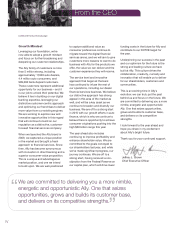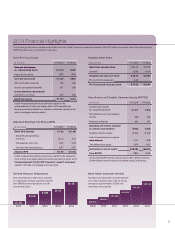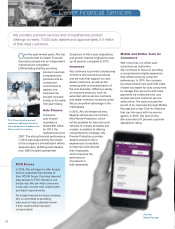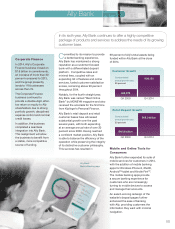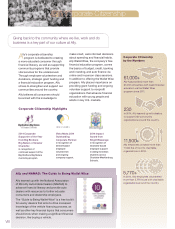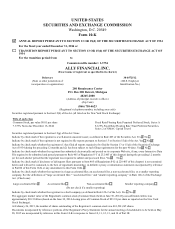Ally Bank 2014 Annual Report Download - page 15
Download and view the complete annual report
Please find page 15 of the 2014 Ally Bank annual report below. You can navigate through the pages in the report by either clicking on the pages listed below, or by using the keyword search tool below to find specific information within the annual report.
Table of Contents
Ally Financial Inc. • Form 10-K
3
A number of provisions in the Dodd-Frank Act have entered into effect while others will become effective at a later date or
after a rulemaking process is completed. While U.S. regulators have finalized many regulations to implement various provisions of
the Dodd-Frank Act, they plan to propose or finalize additional implementing regulations in the future.
Under the Dodd-Frank Act, financial holding companies such as Ally are subjected to a new orderly liquidation authority. The
orderly liquidation authority became effective in July 2010, with implementing regulations adopted thereafter in stages, with some
rulemakings still to come. Under the orderly liquidation authority, the FDIC would be appointed as receiver upon an insolvency of
Ally, giving the FDIC considerable rights and powers that it must exercise with the goal of liquidating and winding up Ally,
including the ability to assign assets and liabilities without the need for creditor consent or prior court review and the ability of the
FDIC to differentiate and determine priority among creditors. In December 2013, the FDIC released its proposed Single Point of
Entry strategy for resolution of a systemically important financial institution under the orderly liquidation authority. The FDIC’s
release outlines how it would use its powers under the orderly liquidation authority to resolve a systemically important financial
institution by placing its top-tier U.S. holding company in receivership and keeping its operating subsidiaries open and out of
insolvency proceedings by transferring the operating subsidiaries to a new bridge holding company, recapitalizing the operating
subsidiaries, and imposing losses on the shareholders and creditors of the holding company in receivership according to their
statutory order of priority.
In February 2014, the FRB issued a final rule to implement certain enhanced prudential standards under the Dodd-Frank Act
for large bank holding companies such as Ally. The final rule generally became effective on January 1, 2015. Among other things,
the final rule requires Ally to maintain a buffer of unencumbered highly liquid assets to meet projected net cash outflows for 30
days over the range of liquidity stress scenarios used in internal stress tests and to comply with a number of risk management and
governance requirements, including liquidity risk management standards. The Federal Reserve has stated that it will issue, at a later
date, final rules to implement certain other enhanced prudential standards under the Dodd-Frank Act for large bank holding
companies, including single counterparty credit limits and an early remediation framework.
To complement the above-mentioned internal liquidity stress testing and liquidity buffer requirements, the FRB and other U.S.
banking regulators issued a final rule in September 2014 to implement the Basel III liquidity coverage ratio (LCR) requirements for
large bank holding companies. The LCR was developed by the Basel Committee on Banking Supervision (Basel Committee) to
ensure banking organizations maintain an amount of high-quality liquid assets that is no less than 100 percent of their total net cash
outflows arising from significant stress over a prospective 30 calendar-day period. The U.S. LCR rule is more stringent in certain
respects compared to the Basel Committee’s version of the LCR, and includes a generally narrower definition of debt and equity
securities that qualify as high-quality liquid assets and a two-year phase-in period that began on January 1, 2015 and ends on
January 1, 2017. A simpler, less stringent U.S. LCR requirement (Modified LCR) applies to depository institution holding
companies with $50 billion or more in total consolidated assets that are not covered by the LCR. The Modified LCR requires
depository institution holding companies to calculate their Modified LCR on a monthly basis beginning January 1, 2016, subject to
a transition period (phased-in implementation with a minimum ratio of 90% in 2016 and 100% in 2017 and beyond). Because Ally’s
total assets are less than $250 billion but greater than $50 billion, and because it has immaterial foreign exposure, Ally is expected
to be subject to the requirements of the Modified LCR.
The CFPB has issued various rules to implement consumer financial protection provisions of the Dodd-Frank Act and related
requirements. Many of these rules impose new requirements on Ally and its business operations. In addition, as an insured
depository institution with total assets of more than $10 billion, Ally Bank is subject to examination by the CFPB with respect to its
compliance with federal consumer financial protection laws and regulations.
• Capital Adequacy Requirements — Ally and Ally Bank are subject to various guidelines as established under FRB and
FDIC regulations. Refer to Note 21 to the Consolidated Financial Statements for additional information. See also “Basel Capital
Frameworks” below.
• Capital Planning and Stress Tests — Pursuant to the Dodd-Frank Act, the FRB has adopted capital planning and stress test
requirements for large bank holding companies, including Ally, which form part of the FRB's Comprehensive Capital Analysis and
Review (CCAR) process. Under the FRB's capital plan rule, Ally must submit an annual capital plan to the FRB, taking into
account the results of stress tests conducted by Ally based on scenarios prescribed by the FRB. The capital plan must include a
description of all planned capital actions over a nine-quarter planning horizon, including any issuance of a debt or equity capital
instrument, any capital distribution, and any similar action that the FRB determines could have an impact on Ally's consolidated
capital. The capital plan must also include a discussion of how Ally will maintain capital above the U.S. Basel III minimum
regulatory capital ratios that are phased in over the nine-quarter planning horizon, and above a Tier 1 common equity-to-total risk-
weighted assets ratio of 5 percent, and serve as a source of strength to Ally Bank. The FRB will either object to Ally's capital plan,
in whole or in part, or provide a notice of non-objection. If the FRB objects to the capital plan, or if certain material events occur
after approval of the plan, Ally must submit a revised capital plan within 30 days. In addition, even with an approved capital plan,
Ally must seek the approval of the FRB before making a capital distribution if, among other factors, Ally would not meet its
regulatory capital requirements after making the proposed capital distribution.
In March 2013, the FRB objected to Ally's 2013 capital plan on both quantitative and qualitative grounds. In September 2013,
Ally submitted a revised capital plan, to which the FRB did not object in November 2013. Ally received no objection to its 2014



